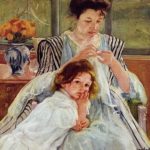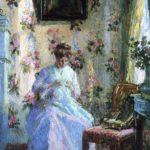Ok, ever wonder about when the first article of clothing was made? What was it made of and what did it look like?
We’re going to take a look into the past and see what we can find.
Sewing is where objects using a needle and some kind of thread. It is one of the oldest “textile arts” that is still around. It began even before the spinning wheel, spinning yarn or even weaving fabric, in the Paleolithic period. Various archaeologists believe that people during the Stone Age, in Europe and Asia, were the ones who sewed their clothing from fur and skin with a bone for a needle and “thread” from various things like sinew, catgut and possible veins. Ivory and antlers were also used as needles.
But sewing didn’t consist of just making clothing, it was also a method used for making quilts, tablecloths, curtains, sheets, as well as for upholstery, shoemaking, bookbinding, sail making, etc. Sewing is pretty versatile and used to make just about anything. Including the handbags and pouches we carry!!
Hand sewing is truly a work of art and has been used for THOUSANDS of years! The invention  of the sewing machine just made it easier for housewives and tailors to make things faster. It took less time to sew something together than it had before. Sewing a quilt was faster too, they didn’t have to wait as long for the quilt to be finished. That made it nice for those cold winter nights.
of the sewing machine just made it easier for housewives and tailors to make things faster. It took less time to sew something together than it had before. Sewing a quilt was faster too, they didn’t have to wait as long for the quilt to be finished. That made it nice for those cold winter nights.
High quality tailoring, custom dressmaking, and haute couture fashion are characterized by the fine hand sewing workmanship. It’s a way to express their creativeness both as a hobby and as a profession.
Ok, we know that Indians used sinew and animal hides to not only make their clothing, but they made their moccasins and their tipis as well. More than likely they used a needle made from bone. Africans used sewing in combination with their basket weaving to hold the leaves together, thus making them sturdier.
Cloth woven from natural fibers stared in the Middle East somewhere around 4000 BCE or earlier during the Neolithic Age, with the sewing of cloth accompanying it. It was the well to do Europeans that had seamstresses and tailors that made their garments for them. It was considered to be the occupation of women and very few men were tailors.
Sewing was looked upon as practical, as clothing was an expensive investment, and sewing was used to mend clothing. Clothes that faded were turned wrong side out and worn that way or they were taken apart and re-sewn with the better side out. Housewives had to make the clothing last as long as they could before new ones were even considered, thus using any means necessary to accomplish that.
 Worn out clothing were often used to make other articles of clothing or cut out for quilt pieces. Women often used their sewing skills for bartering with other women who had a different skill. Sewing was a very important skill to learn as women needed to know how to alter garments, make patterns, etc.
Worn out clothing were often used to make other articles of clothing or cut out for quilt pieces. Women often used their sewing skills for bartering with other women who had a different skill. Sewing was a very important skill to learn as women needed to know how to alter garments, make patterns, etc.
Not only was knowing how to sew clothes a valued skill, but knowing how to do embroidery and decorative stitching was as also considered valuable. Girls were encouraged at young ages to start learning how to sew and embroider.
Sewing became easier once the sewing machine was invented. Clothing could be produced in quantity as textile factories were started. Women were paid very little working in these factories, they would work many hours just to earn some money to support themselves. It was hard work.
Through the centuries the sewing industry has underwent many different changes and improvements. Sewing machines became more affordable for the working class, the demand for sewing patterns increased and as women became more accustomed to the newest and latest fashion, demand for these patterns increased some more.
Sewing patterns became very popular and you could find them in magazines and they came in packets as well. Companies began to show up, selling patterns of all kinds, with lots of different styles.
Today, sewing machines are making all sewing easier, they even have sewing machines you can program to do embroidery!! They have all kinds of functions and stitches!!! There are all kinds of different sewing tools today that the women of the past didn’t have.
Hopefully the art of hand sewing will not become a lost art and people will still use this means of sewing and not rely solely on the sewing machine or other machines to do the work. This form of art is worth keeping alive!!

